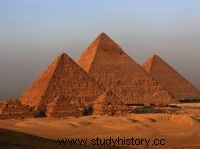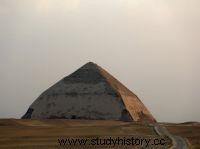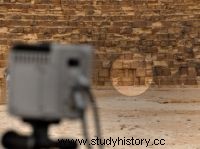The Egyptian Minister of Antiquities has given the green light to the exceptional scientific mission Scan Pyramids, which will focus on 4 pyramids. Story from Giza by our special correspondent Aline Kiner.
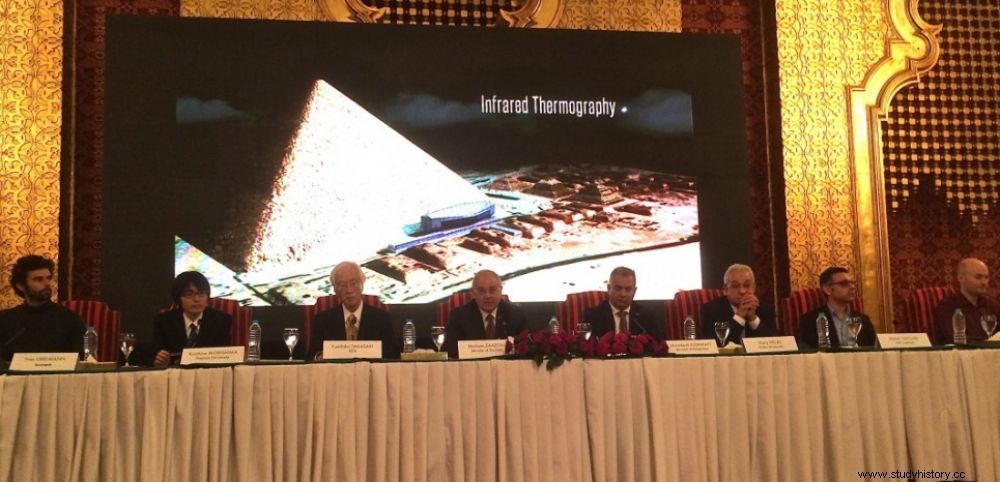
The Scan Pyramids team, on October 25, 2015 in Cairo. This exceptional scientific mission focuses on 4 pyramids built during ancient Egypt.
PYRAMID. Stimulating atmosphere, Sunday, October 25, 2015 in the morning, in the sumptuous living room of the Mena House where the press conference is held which launches the great Egyptian-international operation Scan Pyramids. The contrast is spectacular:on the one hand the slightly outmoded luxury of a mythical hotel – huge crystal chandeliers, walls covered with gilded woodwork; on the other, a screen of 3 meters by 6 where futuristic images scroll:animation of 3D pyramids, bombardments of cosmic particles, drones! Side by side on the platform, Mamdouh Eldamaty, Egyptian Minister of Antiquities, Hesham Zaazou, Minister of Tourism, Hany Helal, from Cairo University and Medhi Tayoubi, from HIP, initiators and implementers of the operation, as well as only three scientists:Mathieu Klein from Laval University, Fumihiko Takasaki from Kek (Japanese equivalent of CEA), Kunihiro Morishima from Nagoya University and Yves Ubelmann from Iconem.
From the first images, and the first interventions, we understand that the mission will implement the most innovative technologies of recent decades. Muons from the cosmos and infrared waves to probe the heart of the pyramids! The Minister announces that it will relate to four masterpieces of the 4th dynasty (2561-2450 BC):the South pyramids, called rhomboidal, and the North, called red pyramid, raised on the site of Dahshur, south of Saqqara, by King Snefru (2575-2551 BC); Kheops and Khephren, built by his son and his grandson, on the plateau of Giza, near Cairo. An exceptional archaeological sequence that may help to answer - finally! - to recurring questions about the construction of these stone colossi and their inexplicable plan and structural anomalies.
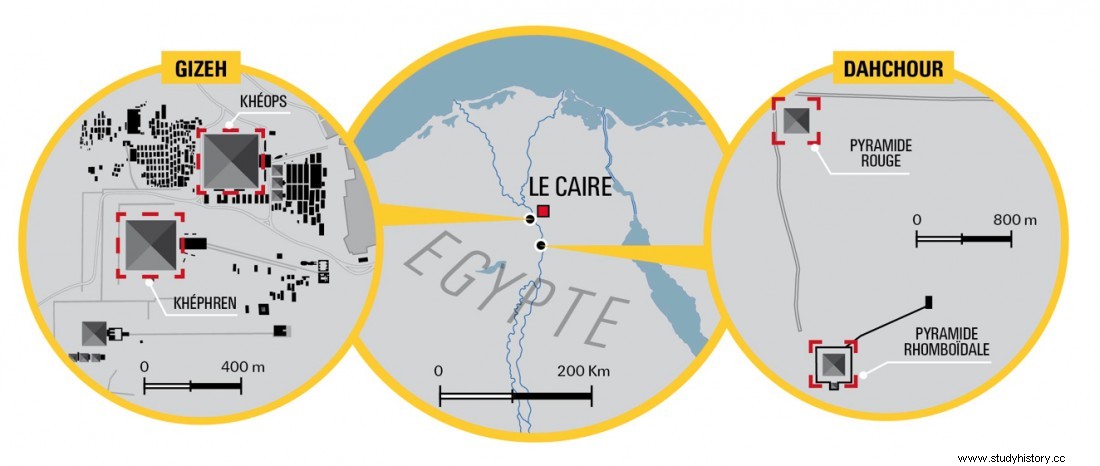
Scan Pyramids therefore brings together three major universities, those of Cairo, Laval in Quebec and Nagoya in Japan, as well as the KEK, the Japanese equivalent of the CEA. It is part of a strong desire, for fifty years, to re-study the funerary monuments of the sovereigns of the Old Empire in the light of new technologies. As early as 1968, the American Luis Alavarez, Nobel Prize winner and member of the Manhattan Project, which enabled the development of nuclear weapons, tried to x-ray their entrails using muons. A failure. But the processes have since been improved, and scientific explorations have followed. Exactly thirty years ago, a microgravimetry mission financed by the EDF foundation in Kheops thus detected areas of under-density, including one in a spiral shape over the entire height of the monument. It was then the turn of a radar mission led by the Japanese University of Waseda to conclude that there was a second corridor parallel to the one leading to the Queen's bedroom. And in 2000 georadar detections highlighted a structure under this same chamber.
Trailer Mission ScanPyramids Version Française from HIP Institute on Vimeo.
Would the essential therefore remain hidden? Zahi Hawass, who for more than ten years was the all-powerful patron of Egyptian Antiquities, did not hesitate to declare, in his time:"I believe that the true burial chamber of Cheops is always hidden inside the pyramid." (1) But these ancient giants are an almost untouchable symbol. And to obtain the approval of the authorities, it took a lot of energy from the initiators and orchestrators of the mission:the Faculty of Engineers of Cairo and the French institute HIP (Heritage, Innovation, Preservation), a structure of general interest non-profit organization funded by patrons (Japanese television NHK, the Dassault Systèmes Foundation, Schneider Electric, etc.). "We were able to convince, because our mission only uses non-destructive techniques" , explains Mehdi Tayoubi, the president of the HIP institute.
In parallel with the four muon and infrared detection campaigns (read the boxes) which will take place from the beginning of November, HIP has commissioned the Iconem company to carry out, using drones, a photogrammetry campaign which will make it possible to recreate in three dimensions, with an unprecedented precision, the Giza plateau and the site of Dashur, as well as their monuments. These models will be made available to the public, in open data. Sharing and transfer are indeed the key words of Scan Pyramids. It is about training experts at the local level. The Japanese team's laboratory, dedicated to the development and analysis of images captured by muons, has already been set up in Cairo. Officially, there is no question of verifying the various theories proposed in recent years, particularly on the construction of monuments. Professor Hany Helal, former minister of research, who leads the mission for the Faculty of Engineering in Cairo, is very clear:"We are engineers, not archaeologists. Our objective is to use techniques to obtain of the results. It is then up to the Egyptologists to interpret them" . Mamdouh Eldamaty announced that 2016 would be the year of the pyramids in Egypt.
UPDATES. At the end of the press conference, the Minister of Egyptian Antiquities also announced that the HIP Institute and the Faculty of Engineering in Cairo will organize the infrared thermography campaign in the tomb of Tutankhamun.
On November 9, 2015, during a press conference, scientists from the HIP Institute and the Faculty of Engineering in Cairo reveal the first results of their infrared campaign which shows a temperature anomaly on the east face of the pyramid of Kheops:6 degrees difference between two neighboring blocks.
LEARN MORE.
Interview with Mehdi Tayoubi, from the French HIP Institute. The coordinator of the Scan Pyramids mission talks about this exceptional mission which will focus on 4 Egyptian pyramids.
Professor at the Faculty of Engineering in Cairo Hany Helal answers questions from Sciences et Avenir :"Scan Pyramids brings together the most innovative techniques".
(1) On the sidelines of the 9th International Congress of Egyptologists, 2004.
Infrared thermography (short mission)
For ten days, the specialist Jean-Claude Barré (LedLiquid) will rotate, to the rhythm of the sun, around the pyramids, infrared camera in hand, in order to establish a thermal map. Because like all materials, the stones of these giants radiate energy according to their temperature, emitting infrared waves. Thanks to a digital model, the camera captures and measures these waves, then generates color images:from blue for very cold weather to red for very hot weather. "Possible cold areas on the surface of the pyramids could reveal air currents, therefore cavities, chambers or corridors just below" , explains Jean-Claude Barré. His program:to take images on the four faces of the monuments half an hour before sunrise, when having evacuated a maximum of energy during the night, they will be cold. And from this point 0, which will serve as a standard, repeat the operation at noon and in the evening.
Modulated thermography (long mission)
It is not on a daily basis, like Jean-Claude Barré, that the Laval University team will take the temperature of the pyramids, but annually! If it is still a question of measuring infrared waves, what matters this time is the time it will take to return from inside buildings once they have been heated by the sun. The idea here is also to record the evolution of the surface temperature in the form of thermal images. But the technique implemented by Quebecers is based on repeated modulation of the heating source, here the sun. The slower the periodic heating variation, the deeper the heat wave produced penetrates the material. Seasonal temperature variations are therefore ideal for probing the heart of the pyramids."If all goes well, explains Professor Xavier Maldague, the thermal waves generated by these variations should propagate very slowly in the monument. Wherever it is massive, they will disappear. But if they encounter a rock/air interface, they will reflect, bounce, and come back to the surface." A return phenomenon which will allow us to presume the presence of a cavity in the masonry. "The signal recovered will be very weak. We must therefore multiply the measurements to be sure of capturing it and being able to distinguish it from other signals , random." , concludes Xavier Maldague. A two-year cycle would be ideal.
Muons
Muons are elementary particles, coming from the upper layers of the Earth's atmosphere, which bombard the earth with a permanent rate of about 10,000 per m
2
per minute. Like the X-rays that pass through our body and allow us to visualize our skeleton, these kinds of heavy electrons can pass through very thick rocks. Muon radiography is now frequently used in the observation of volcanoes, in particular by research teams at the University of Nagoya.
More recently, the KEK has developed a detection approach based on electronic scintillators that are resistant, unlike chemical emulsions, to nuclear radiation, in order to scan the interior of the reactors of the Fukushima power plant. In the case of the pyramids, detectors placed inside the buildings, at places chosen according to the anomalies of density and structure, will make it possible to discern the zones of vacuum (which the muons will have passed without problem) and the zones more dense where some of them will have been absorbed or deflected. It will probably take several months of data to generate images with enough contrast to be readable.
Muon radiography is frequently used today in the observation of volcanoes, in particular by research teams at the University of Nagoya. More recently the KEK (Japanese equivalent of the CEA) has developed a detection approach based on electronic scintillators resistant, unlike chemical emulsions, to nuclear radiation, in order to scan the interior of the Fukushima power plant.
IN IMAGES, IN PICTURES. In the bowels of the Egyptian pyramids

